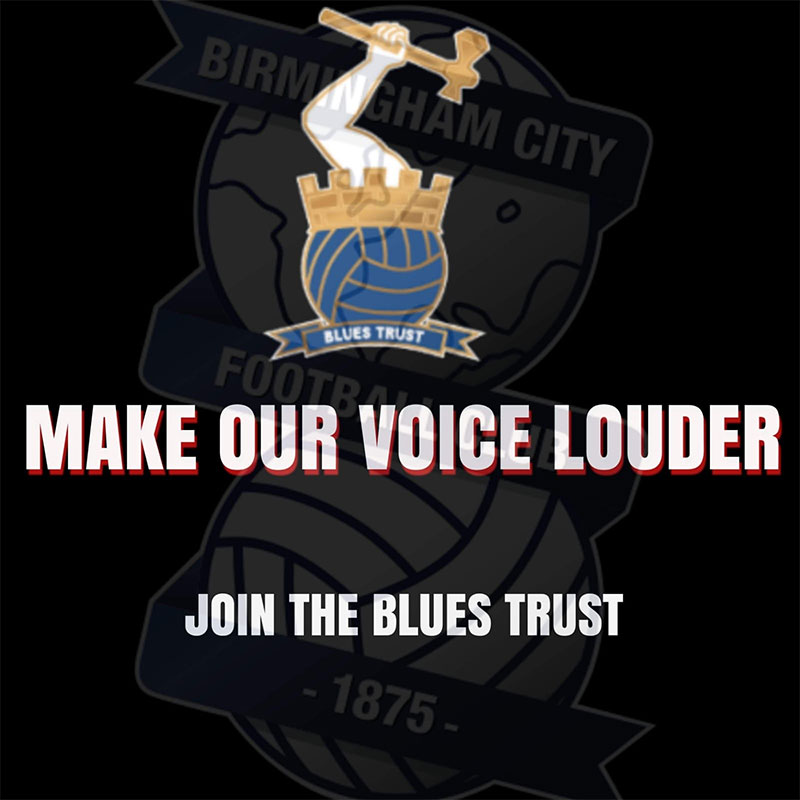Blues 2020/21 Accounts

Let’s start with revenue.
Revenue – Covid 19 reduced Blues income by over £9m
| Revenue (£m) | 2021 | 2020 | 2019 | 2018 |
| Match Day | 0.0 | 4.6 | 5.0 | 4.9 |
| Broadcasting | 9.3 | 8.8 | 8.0 | 7.6 |
| Commercial | 3.8 | 9.1 | 10.0 | 6.3 |
| Turnover | 13.1 | 22.5 | 23.0 | 18.8 |
| Other income | 1.8 | 1.5 | 0.7 | 0.7 |
From a revenue perspective the impact of Covid has been significant – matchday revenue has shrunk to zero and commercial revenue contracted significantly. The overall impact was to reduce turnover to £13.1m a reduction of £9.4m on 2020 and a reduction of £9.9m on the last year of unhindered operations 2019.
Other income (which almost certainly includes Coventry City’s leasing of the ground for just over £1m) provided a small bonus.
Operating Costs – Blues total wage bill is still over £30m
| Operating costs £m | 2021 | 2020 | 2019 | 2018 |
| Employment costs | (30.2) | (32.4) | (33.0) | (38.0) |
| Other Expenses | (6.6) | (10.9) | (11.1) | (11.6) |
| Depreciation | (1.2) | (1.3) | (0.9) | (0.9) |
| Player Amortisation | (7.2) | (8.3) | (8.0) | (7.6) |
| Total Op cost | (45.1) | (53.0) | (52.9) | (58.1) |
| Wages/turnover (%) | 230% | 144% | 143% | 202% |
On costs Blues total wage bill was still over £30m – although it was slightly down on 2020. Blues wages to turnover ratio was a staggering 230%. As we have seen turnover was impacted by Covid but even if we assume turnover in a ‘normal’ year (taking 2019 turnover figures) that still gives a wages/turnover ratio of 131%. These figures just emphasise why Craig Gardener is constantly talking about getting the wage bill down.
The accounts also show that the club’s highest paid director (Assumed to be Dong) had a pay rise of £82,000 to £366,000 and that from December 2020 the club – and not the Hong Kong-based parent company Birmingham Sports Holdings Ltd, would take over paying directors.
Elsewhere there was a significant reduction in operating expenses – partly due no doubt to not having to handle crowds. Player amortisation, which spreads transfer fees paid over the length of a players’ contracts, was still over £7m.
Overall, although total operating costs were down, they were still significantly higher than income.
Operating Profit – Blues still made a significant loss on operations
Putting these together gave an operating loss of over £30m – similar to the last couple of years.
| Revenue (£m) | 2021 | 2020 | 2019 | 2018 |
| Operating Profit /loss (£) | (30.2) | (29.0) | (29.2) | (38.6) |
Player Transfers – Blues made a large profit on player sales due to Jude Bellingham’s sale to Dortmund
The overall profit figure also includes any profit on player sales – and as shown below Blues made a healthy profit on transfers, largely due to Jude Bellingham’s sale.
The overall transfer picture for 2020/21 is shown below. Blues spent £6m getting players in but had sales of over £27m. (It should be noted that the purchases row is probably more accurately described as the cost of player registrations – it would usually include transfer fees, loan fees, agent fees and lawyer fees etc. – also under current accounting rules neither purchases or sales would include any conditional payments not yet triggered.)
It can also be seen that after investing strongly in players in 2018 Blues have become a selling club since then.
| Transfers (£m) | 2021 | 2020 | 2019 | 2018 |
| Purchases | (6.0) | (10.5) | (7.4) | (15.0) |
| Sales | 27.6 | 12.6 | 7.7 | 4.0 |
| Net Sales/(Spend) | 21.6 | 2.0 | 0.2 | (11.0) |
The profit on player sales is slightly below the total sales figure as the accounting value for the player on the club’s balance sheet has to be subtracted. For Blues this gives a healthy profit on player sales for 2021.
| 2021 | 2020 | 2019 | 2018 | |
| Profit on player sales (£m) | 26.5 | 11.5 | 4.4 | 2.0 |
Profit and loss – Jude Bellingham’s sale to Dortmund helps reduce the total loss to £4.7m
Putting the revenue and costs together gives the following total profit and loss
| P&L (£m) | 2021 | 2020 | 2019 | 2018 |
| Profit before tax | (4.7) | (18.4) | (8.1) | (37.5) |
Blues recorded on overall loss of £4.7m. Looking at the picture over the last three years, Blues would be still well within the Profitability and sustainability criteria but over the long run such losses are unsustainable unless the club regularly makes a profit on the sale of players and/or is funded through cash put in by the owner.
Debt – Blues used loans from the banks and EFL in 2021 to help cover its operating expenses. Overall the debt to the owners has reduced.
Over and above the profit and loss figures there are some interesting things going on when looking at the club’s debt.
In recent history the club has relied on cash injections from the owners to continue operating as shown below:
| 2021 | 2020 | 2019 | 2018 | |
| Cash put in by owner (£m) | NIL? | 18.9 | 23.8 | 39.7 |
This year however was different. First of all, the club secured an interest free loan from the EFL of over £7m to help cover operating expenses during the pandemic. This is repayable in instalments up to 2024.
Secondly the club also received a loan from Macquarie bank for £17.3m secured against future transfer fee receivables from Dortmund and Southampton from the Bellingham and Adams sales.
Together, along with earlier transfer fee payments, these seem to have been enough to cover the club’s operating expenses for 2021.
Although the owners made some small loans during the year there were also some repayments too and, across the year, it looks like the owners’ net did not have to put money into the club.
In fact, the debt to the owners shown in the accounts (This debt is due to a combination of BHSL and ORI via the UK Holding company Birmingham City Plc) has reduced as shown below:
| 2021 | 2020 | 2019 | 2018 | |
| Debt to the owners (£m) | 87.0 | 110.3 | 91.4 | 73.1 |
Why could this be? A large element of this would appear to be linked to the sale of the ground. When the ground was sold originally the club received an IOU from Birmingham City Stadium Limited (BCSL) for the ground. In 2020 this was shown in the accounts as “Amounts owed by the group undertakings” and amounted to £21.5m. In this year’s accounts it is zero and it appears that this amount has been used to offset some of the debt the club owes.
As per the sale agreement for the ground some cash went to BHSL to help pay off external debt but there is also some money owed to the football club which is shown as a £5.5m debt to the company in the accounts.
Whilst it is good to see the debt reduce, the accounts highlight that a further £40m of owner input will be required from June 2021 up to January 2023 and that the owners are confident that they have the money in place to do this.
Summary
Overall the accounts are pretty mixed. The sale of Bellingham (and Adams) helped the club through the difficult Covid times but progress continues to be slow on the club becoming more sustainable highlighted by the large wage bill and the requirement for another £40m of owner funding.
Blues Trust
By making comments:
- All we ask is that it relates to the Club that we all love. It can inform, question, challenge, criticise even….but it should not be written to threaten and/or cause personal offence.
- By making comments on the above article, you agree to Blues Trust retaining your email address should we need to make contact with you for admin purposes. Let us know at admin@bluestrust.org if you do not wish us to do this. We will not give out your email address to any 3rd party sources.
The Trust reserves the right to moderate any comments made (in consultation with the writer) or to deny publication if comments are considered to be inconsistent with the requirements identified above.


This has been set out and explained brilliantly thank you
A half open stadium and overpaid poor players ..BHSL out
Problems go back further than the current regime I’m afraid but they have not covered themselves in glory.Future,watch this space
Baffling to see how we actually survive.Great disclosure by the Blues Trust however and appreciated.